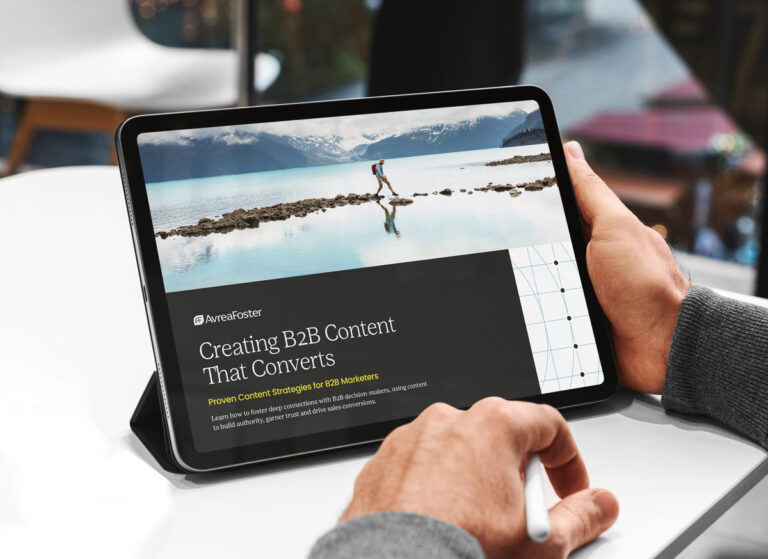Whether you know it or not, you are part of someone’s account-based marketing (ABM) strategy. Somewhere out there, there’s a B2B marketing team that has you squarely on its ABM hit list. It’s creating content that addresses your business challenges, serving ads on your favorite social media channels and methodically stepping you through its custom-built ABM funnel.
In today’s world of B2B marketing, ABM is no longer a component of a smart sales and marketing strategy — it has become the strategy. ABM is key to driving demand generation, enhancing sales enablement and delivering results for B2B marketers.
At AvreaFoster, we’ve spent decades helping B2B companies refine their digital marketing strategies — using ABM to build stronger, more profitable relationships with high-value accounts. But how does ABM work, and how can you build a successful ABM strategy that integrates seamlessly with sales and marketing efforts? In this article, we’ll explore how to develop account targets, nurture leads, leverage ABM automation tools and track campaign success.
How ABM Works: A Shift From Broad to Narrow
Unlike traditional marketing, which follows a linear process — attract, engage and convert — ABM takes a fundamentally different approach. Instead of casting a wide net, ABM treats individual accounts as markets in their own right — using personalized engagement to build meaningful, long-term relationships.
One of the biggest advantages of ABM is its ability to transition from broad outreach to highly targeted, personalized engagement. The approach starts wide — capturing as many potential accounts as possible — and gradually narrows the focus to those with the highest intent to purchase. At AvreaFoster, our ABM framework includes three distinct phases.
01
Phase 1: One-to-Many
The ABM journey begins with the one-to-many stage, in which marketing leads the effort to target thousands of prospects. The primary goal of this phase is demand generation — raising awareness and driving lead generation through targeted outreach.
During this phase, the focus is on capability awareness and broad lead generation rather than direct sales. The targets include entire industries and companies that fit the ideal customer profile (ICP) rather than specific individuals. Personalization is minimal, usually limited to industry, product category or general business attributes.
To achieve this, we help clients develop B2B inbound marketing strategies and content that include e-books, webinars, white papers and newsletter sign-ups distributed through search, display ads and paid social campaigns.
The ultimate goal of the one-to-many phase is to generate engagement and move B2B marketing prospects further into the sales funnel.
02
Phase 2: One-to-Few
As prospects engage with your content, ABM efforts transition to the one-to-few stage, targeting hundreds of high-intent accounts. This phase requires tight collaboration between marketing and sales as the focus shifts from lead generation to nurturing and building credibility.
In this phase, marketing and sales teams work together to prioritize high-intent accounts — those that have downloaded content, visited key web pages or engaged with ABM-driven messaging. The level of personalization increases, with messages now tailored to specific industries and buyer personas.
Here, we begin to refine your one-to-few efforts using a mix of online and offline tactics: email marketing, CRM-driven reengagement, digital display ads and increasingly personalized content marketing. By leveraging CRM data from platforms like HubSpot or Salesforce, marketing and sales teams can pinpoint marketing-qualified leads (MQLs) and convert them into sales-qualified leads (SQLs) — and eventually hand them over to the sales team for additional nurturing.
03
Phase 3: One-to-One
At the final stage, ABM becomes a one-to-one effort that targets a select group of 10 to 20 high-priority accounts that are most likely to convert. This phase marks the shift from marketing-led engagement to sales-driven relationship building, with a focus on closing deals through personalized, curated content.
In this phase, the goal is to build direct relationships with key decision-makers and influencers. Every interaction is highly tailored, based on each account’s business goals, pain points and buyer journey stage.
At AvreaFoster, we work with B2B marketing and sales teams to create hyper-personalized content experiences. Tactics in this phase include one-on-one emails, customized case studies, blog posts, podcasts and solution-specific landing pages — all designed to reinforce trust and drive conversion. By the end of this phase, the relationship between the B2B brand and the target account is no longer transactional. It’s a strategic relationship.
How to Build a B2B ABM Strategy
Developing a strong ABM strategy requires a structured, data-driven approach. The first step is to define your ideal customer profile (ICP) by identifying the types of accounts that bring the most value to your business. Those might be based on criteria such as industry, company size and geographic location. Once your ICP is established, the next step is to develop account targets by analyzing CRM data and ABM automation insights. The key is to prioritize accounts that show strong buying signals, such as repeated website visits, high engagement with content or a history of interactions with sales and marketing teams.
With target accounts in place, personalization becomes essential. By tailoring your messaging to address each account’s specific business challenges and opportunities, you increase the likelihood of engagement and conversion. At AvreaFoster, we help clients craft ABM campaigns that deliver high-impact personalization at scale. To streamline execution, leveraging ABM automation tools (like Demandbase, 6sense and HubSpot) can help automate account targeting, campaign tracking and performance analytics.
Key ABM Campaign Metrics to Track
To measure success, ABM efforts require tracking metrics that go beyond traditional marketing KPIs. The most important ABM campaign metrics include:
- Account engagement — Track how target accounts interact with your campaigns through email opens, webinar attendance and website visits.
- Pipeline velocity — Measure how quickly accounts move through the sales funnel.
- Revenue impact — Assess the revenue generated from ABM accounts to determine ROI.
- Customer retention — Evaluate your ability to retain and expand high-value accounts.
These insights help refine and optimize your ABM strategy over time.
Demand Generation Meets Sales Enablement
Best Practices for Long-Term ABM Success
- Start small. Begin with a handful of accounts to test and refine your approach.
- Align teams. Cross-functional collaboration is critical so set expectations and processes early.
- Stay the course. ABM doesn’t replace traditional marketing. It supplements it with deeper engagement and personalization.
Ready to Get Started with ABM?
Account-based marketing offers a clear path to aligning your marketing and sales efforts while driving demand and revenue. By treating individual accounts as their own markets and focusing on deep personalization, ABM delivers results that traditional marketing often can’t achieve. Need help crafting your ABM approach? At AvreaFoster, we’ve helped B2B clients design, launch and optimize ABM strategies.
Contact us today to learn how we deliver results using ABM.




